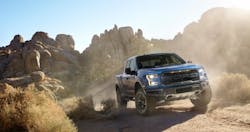When you’re building a specialty-model pickup, you know it’s got to be brutal enough to withstand more than the average amount punishment in order to command a higher price point on the market.
I mean, sure, it’s got to look nice and provide beefier power and performance compared to its run-of-the-mill brethren, but if it can’t withstand significant off-road pounding in the bargain as well, you won’t getting a premium for it for very long.That’s one of the philosophical drivers Ford Motor Co. is obliquely following when it subjected its 2017 model F-150 Raptor pickup to 1,028 miles of testing recently along harsh desert trails in the southwestern U.S.
Designed to parallel the Baja race course in Mexico, Ford said its 66-mile test route featured a wide range of surfaces including fast sandy washes, deep-rutted silt beds, steep climbs in deep sand, and slow meticulous crawls through tight trenches.
The OEM noted that vehicles is this test are early-build prototypes made from a mix of 2015 F-150 and 2017 F-150 Raptor components.
Through it all, the OEM said its engineers pushed the 2017 prototype Raptor hard; harder than it would be pushed over the lifetime of a typical vehicle and far exceeding what an owner typically would do on an off-road trail.Ford noted that its test Raptors hit top speeds of 100 mph along parts of its desert test track, while slowing to 10 mph in others, for an average speed of approximately 50 mph along the course.
At the end of each lap, Ford said its 2017 prototype Raptor completed a tabletop jump consisting of a steep ramp up to a two-foot plateau, then a step-off back to level ground.
Interestingly, Ford added that its 2017 Raptor is 25% faster than the current model based on lap times.
The OEM emphasized that testing isn’t close to being done on its latest iteration of the F-150 Raptor, with more planned well into 2016. Ford noted that a final production version of its 2017 model F-150 Raptor should be ready to go on sale in the fall of next year.
Obviously, the F-150 Raptor looks very different from a standard F-150 design, but how does it differ specifically? Here are a few points the OEM highlighted when it rolled out its 2016 model Raptor back in January this year:
- Raptor models are 6 inches wider than the standard F-150 for improved stability off-road.
- Raptor’s sport Ford’s first-ever dual exhaust for pickups and 17-inch wheels with next-generation BFGoodrich All-Terrain KO2 tires specifically designed for off-road performance.
- The truck is powered by what the OEM calls a “second-generation” 3.5-liter EcoBoost engine exclusive to the Raptor line, mated to an all-new 10-speed transmission. Ford said that new “high energy” 2.5-liter EcBoost generates more power than the OEM’s current 6.2-liter V8, which is rated at 411 hp and cranks out 434 lb.-ft. of torque.
- The 2016 Raptor featured an all-new four-wheel-drive, torque-on-demand transfer case, with an advanced, easier-to-use version of off-road mode driver-assist technology.
- Ford said the Raptor’s new transfer case, which manages power distribution between front and rear wheels, combines the best attributes of clutch-driven, on-demand all-wheel drive with durable, mechanical-locking four-wheel drive.
- The Raptor comes standard with new FOX Racing Shox with custom internal bypass technology that works to damp and stiffen suspension travel over rough terrain to help prevent the truck from bottoming out.
- Ford noted that those front and rear shock canisters are bigger, at 3 inches in diameter, to boost off-road performance.
Yet the advances Ford made to its off-road mode driving technology is something that may migrate in stages to its “regular” pickups, as fleets working in some hard-scrabble areas of the U.S. could certainly use the capability such systems offer.
Indeed, Ford said its off-road driving package has “evolved” into what it calls its Terrain Management System; technology that enables drivers to select specific modes of operation to “optimize” driving dynamics to environmental conditions – from snow to mud, sand and more.
Specific calibration changes to the Raptor’s powertrain, driveline, traction control, ABS [anti-lock braking system] and AdvanceTrac stability control are all linked so the OEM can offer six “preset driving modes” for the Raptor depending on terrain and driving conditions:
- Normal mode for everyday driving
- Street mode for higher-performance, on-road driving
- Weather mode for rain, snow or ice
- Mud and sand mode for muddy and sandy trails and terrain
- Baja mode for high-speed desert running
- Rock mode for low-speed rock crawling
Ford noted that an optional Torsen front differential increases the Raptor’s off-road capability further, as it increases grip significantly for the front end of the truck and allows it to pull itself over obstacles and up steep grades – even when traction is split between the front tires.
Again, that kind of off-road capability is not something every fleet operating pickup trucks necessarily needs.
But for those working frequently in tough environments – serving remote oilfields, backcountry forests and mountain ranges, and, yes, hard-to-traverse desert locales – the capabilities offered by specialty pickups such as Ford’s Raptor may be highly prized indeed.



